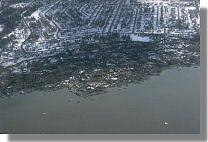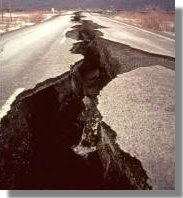As a part of the Pacific Ring, the southern coast area of
Alaska experiences many earthquakes. On Good Friday, March 27, 1964, a great
earthquake of magnitude 9.2 struck Prince William Sound and
 caused severe damage in the form of landslides and liquefaction as
seen in the pictures (SC).
This seismic event is not only the second largest ever to have been recorded
but it lasted for over 3 minutes (radio
announcement) and was felt over an area of 500,000 square miles. A
tsunami,
heavily increased the amount of damage to wharf and waterfront facilities, and caused
five deaths hours after the earthquake in Crescent City, California
caused severe damage in the form of landslides and liquefaction as
seen in the pictures (SC).
This seismic event is not only the second largest ever to have been recorded
but it lasted for over 3 minutes (radio
announcement) and was felt over an area of 500,000 square miles. A
tsunami,
heavily increased the amount of damage to wharf and waterfront facilities, and caused
five deaths hours after the earthquake in Crescent City, California
Liquefaction
Liquefaction in sand layers,
 and in sand and
silt seams in the clayey soils beneath Anchorage, caused many of the
destructive landslides that occurred during the earthquake
(Seed 1973). The
liquefied seams and lenses disturbed the sensitive clays, and caused their
strengths to drop below the levels needed for stability. Click on the picture
to the right for an explanation of the shown road embankment failure.
and in sand and
silt seams in the clayey soils beneath Anchorage, caused many of the
destructive landslides that occurred during the earthquake
(Seed 1973). The
liquefied seams and lenses disturbed the sensitive clays, and caused their
strengths to drop below the levels needed for stability. Click on the picture
to the right for an explanation of the shown road embankment failure. |



